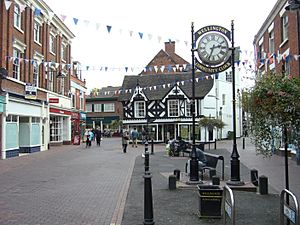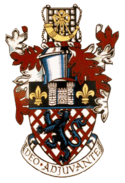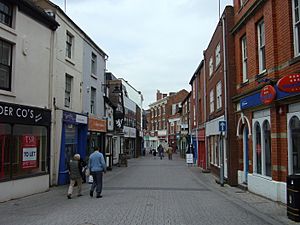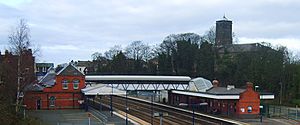Wellington, Shropshire facts for kids
Quick facts for kids Wellington |
|
|---|---|
 Street view of the pedestrianised centre of Wellington |
|
 Parish coat of arms |
|
| Population | 25,554 |
| OS grid reference | SJ651115 |
| Civil parish |
|
| Unitary authority | |
| Ceremonial county | |
| Region | |
| Country | England |
| Sovereign state | United Kingdom |
| Post town | TELFORD |
| Postcode district | TF1 |
| Dialling code | 01952 |
| Police | West Mercia |
| Fire | Shropshire |
| Ambulance | West Midlands |
| EU Parliament | West Midlands |
| UK Parliament |
|
Wellington is a market town in Telford and Wrekin, Shropshire, England. It is situated 4 miles (6 km) northwest of central Telford and 12 miles (19 km) east of Shrewsbury. The summit of The Wrekin lies 3 miles southwest of the town.
The total town population of Wellington was 25,554 in 2011, making it by far the largest of the borough towns and the third largest town in Shropshire if counting it as its own town separate from Telford itself.
Contents
History
Its name is most likely derived from that of a Saxon settler - Weola - whose farmstead would have been located somewhere in the centre of town, possibly near The Green. A church has stood near that site for almost 1000 years and a priest is mentioned in the Domesday Book. The original churchyard still remains. A new church, designed by George Steuart, was built in 1789.
Wellington's first market charter was granted to Giles of Erdington, lord of the manor, and is dated 1244 (See citation in external links) and a market still exists today. The market had an open-sided market hall by 1680 - and possibly much earlier - but this was dismantled c.1805 (See Citation in external links). In 1841, a market company formed to purchase the market rights from Lord Forester in 1856. Several years later in 1848, the company built a town hall with the butter market below, creating a permanent covered home for traders.
In 1642 King Charles I stayed overnight 'in the environs of Wellington (i.e. not in the town itself) when on his way from Newport to Shrewsbury to rally support for his cause (and to exchange cash for honours), and while here he made his 'Wellington Declaration' in which he said that he would uphold the Protestant Religion, the Laws of England, and the Liberty of Parliament.
The second Shropshire Olympian Games, organised by celebrated Olympic revivalist Dr William Penny Brookes, were held in Wellington in May 1861.
To the north-east of the town is the site of Apley Castle, originally a fourteenth-century fortified manor house, the remains of which were converted into a stable block with the building of a grand Georgian house, which was itself demolished in the 1950s. The surviving stable block has been converted into apartments and retains some medieval features.
The creation of Telford
Dawley New Town was designated by the Government in 1963, and was expanded to encompass Wellington in 1968 under the new name of Telford, named for the great engineer and first county surveyor of Shropshire, Thomas Telford. The creation of Telford has divided opinion in Wellington ever since, with some celebrating the jobs and investment it brought to the area and others bemoaning the negative impact on Wellington's own economy – as well as its status and sense of identity. The development of Telford Town Centre since the 1970s has hit Wellington's retail centre hard. In addition, moves such as the renaming of the local football team from Wellington Town to Telford United highlighted to many that Wellington was being erased as a town in its own right.
Local politics left Wellington in conflict with Wrekin District (now Telford & Wrekin) Council for many years, with claims and counter claims of neglect. In more recent years, however, the Council has started making heavy investment to make improvements to the town. Chief amongst these has been the redeveloped Wellington Civic and Leisure Centre near the centre of the town, which has brought together the library, town council, swimming pool and gymn, along with a new registry office. 200 borough council officers are also located at the new complex.
Attractions
The Wrekin, one of Shropshire's most famous landmarks, provides Wellington with a rolling green backdrop to the south-west. Located just two miles from the centre of the town, it brings tens of thousands of walkers and cyclists to Wellington every year.
Located in the town's Victorian market hall, Wellington Market operates four days a week and houses over 100 stalls selling everything from local cheese to pipe tobacco. A Farmers' Market also takes place on the fourth Saturday of the month, bringing together several Shropshire food producers and retailers in the market's historic home of Market Square. Local volunteers are working with the Market Company to expand the monthly market and raise its profile.
A short walk from the centre of the town is Sunnycroft, a Victorian villa and mini-estate now owned and run by the National Trust.
The New Buck's Head football stadium, home to A.F.C. Telford United, is located in Wellington. Other sporting clubs include the Wellington Cricket Club, currently in the Birmingham League Premier Division, and Wrekin Golf Club.
Wellington is also home to the Belfrey Theatre an amateur venue run by the Wellington Theatre Company which puts on an annual season of plays and other shows.
Events
Wellington has started to build a reputation for community-led arts and heritage events in recent years. The area's music and theatre groups host performances throughout the year, and amongst other regular events are craft markets at both Belmont Hall and Christ Church (first Saturday of the month).
In March, the town marks Charter Day, when the 1244 charter is delivered by a messenger on horseback. A jury then convenes in the Market Square to appoint the town crier, ale taster and market clerk for the year ahead.
During the summer, around 40 events take place in and around the town, including the historically-inspired Midsummer Fayre, the town carnival and Lions Day at Bowring Park, and the Wellington Walking Festival. Sounds in The Square brings live music to the heart of the town across weekends in July and August, and various concerts and fetes complete the programme.
Autumn kicks off with The Wrekin Barrel Race, when teams race to carry a nine-gallon beer barrel to the top of The Wrekin hill. In October, The Wellington Literary Festival heralds a month-long series of talks and workshops with nationally-known authors and broadcasters, alongside local writers and historians.
Transport
Wellington has road links, centrally located railway and bus stations, and a position on routes 45 and 81 of the National Cycle Network.
Wellington railway station was built in 1849 and has three platforms, served by Avanti West Coast (which replaced Virgin Trains West Coast), Transport for Wales, and West Midlands Trains providing northbound trains towards Shrewsbury and Wales, and southbound trains to the West Midlands and London Euston. One of the platforms is a bay platform, which sees little use at present. Additionally, from 2008 to 2011 the town had a through train service to London Marylebone operated by Wrexham & Shropshire, the first for almost 40 years.
In 1867, a branch line was opened to connect the town with Market Drayton. The Wellington and Market Drayton Railway operated for just under one hundred years before closure under the Beeching Axe in 1963. The line remained open for goods only services until 1967, when this service was also withdrawn. The track was lifted in the early 1970s.
There were also railway links to Much Wenlock and Stafford, both closed in the late 1960s.
A goods only link to a rail head at Donnington, on part of the former Wellington to Stafford line, has been re-opened. There has been some campaigning to re-open the whole of the line from Shrewsbury to Stafford through Wellington, Leegomery, Hadley, Trench, Donnington, and Newport.
Wellington is located at the western terminus of the M54 motorway Junction 7 and has good bus services making it one of the most accessible towns in Shropshire.
Community projects
A number of community organisations are active in the town. Wellington's 'Walkers are Welcome' Group, for instance, organises regular walks around the area in addition to the annual Walking Festival, and Wellington H2A promote arts and heritage in the town through a range of events. Local history and heritage are also promoted by Wellington History Group and Wellington Civic Society. A twinning group exists to maintain links with Wellington's twin town of Chatenay-Malabry in France.
Amongst current community projects are the Peace Garden, started by local nonagenarian George Evans, and the ambitious project to reopen the former Clifton Cinema as a multi-purpose community-owned arts centre, since the building was vacated by previous occupants Dunelm in 2012.
Notable people
The town's literary claims to fame include it being the birthplace of 19th-century writer Hesba Stretton (1832–1911), and the first job of poet Philip Larkin was as librarian of Wellington Library from 1943 to circa 1945. Larkin described Wellington as a "hole full of toad's turds" and stated that his job as town librarian was to "hand out tripey novels to morons". A walkway at the side of Wellington Library was named Larkin Way in honour of Philip Larkin, but this pathway was lost during re-development work on the library. Larkin Way, in a slightly modified form, still exists. The address of Wellington Civic and Leisure Centre is Larkin Way, Tan Bank, Wellington, Telford, TF1 1LX.
The Rev Patrick Brontë lived in the town for a year while serving a curacy before moving to Yorkshire and meeting his future wife there, Maria Branwell. The abolitionist Dr William Withering was born in the town in 1741; he also investigated digitalis, used in the treatment of heart disease. Several members of the pop group T'Pau, including vocalist Carol Decker and keyboardist Michael Chetwood, grew up in Wellington – the latter returning to run a music shop in the town.
Other notable people born, educated or prominent in Wellington include:
- Thomas Leigh (1504–1571), born there, Lord Mayor of London 1558-59
- Richard Baxter (1615–1691), puritan church leader and scholar.
- George Downing (1685–1749), politician, founder of Downing College, Cambridge. He was brought up in the household of his maternal aunt at Dothill Park, her husband being politician Sir William Forester (1655-1718).
- Andrew Plimer (c. 1763–1837), miniature painter.
- Edward Pryce Owen (1788–1863), artist, was vicar of Wellington 1823-1840
- Richard Padmore (1789–1881), Liberal politician and industrialist, born there
- Henry Gauntlett (1805–1876), composer, organist and organ designer, born there
- Robert William Eyton (1815–1881), antiquary, born there, son of local vicar
- Cecil Lawson (1849–1882), landscape artist, born there
- John Parton (1863–1906), cricketer, born there
- Alf Littlehales (1867–1942), footballer, born there; played for Wolves, Stoke City and Southampton.
- Jackery Jones (1877–1945), footballer, born there, played for Wolves.
- Billy Scarratt (1878–1958), footballer, born and died there, played notably for Shrewsbury Town.
- Watty Corbett (1880–1960), footballer, born there; player for Aston Villa and England international who won gold medal in 1908 Summer Olympics.
- Charlie Millington (1882–1945), footballer who appeared in Football League for Aston Villa, Fulham and Birmingham City, died there.
- Harry Hampton (1885–1963), footballer, born there, brought up in Victoria Street, played for Wellington Town before, and after, his more distinguished playing for Aston Villa.
- William Allison White (1894–1974), World War I Victoria Cross recipient, died there.
- George Davies (1900–1942), footballer, born there, played for Birmingham City and Southend United.
- Tommy Pritchard (1904–1968), footballer, born there, played especially for Wolves and Charlton Athletic.
- Des Fawcett (1905–1968), footballer who played in over 300 Football League matches for six clubs, ending his play career with Wellington Town; died there.
- George Ambler Wilson (1906–1977), civil engineer, born there.
- Len Murray (1922–2004), trade union leader, educated at Wellington Grammar School.
- Peter Vaughan (1923–2016) actor, lived in Wellington before moving to Staffordshire at age seven.
- Tommy Nicholls (1931–2021), featherweight boxer who competed at 1952 and 1956 Olympics.
- Brian Epstein (1934–1967), manager of The Beatles studied at Wrekin College.
- Gerry Fowler (1935-1993), Labour Party politician, lived there while MP for The Wrekin and local councillor.
- Nigel Rogers (1936-2022), tenor opera singer and musical conductor, born there.
- Peter Thornley (b. 1941), professional wrestler best known for the ring character Kendo Nagasaki, born there
- Tony McPhee (b. 1944), lead guitarist, and founder of blues/rock band The Groundhogs.
- Paulette Wilson (1956-2020), immigration rights activist, was brought up here after her parents arrived from Jamaica.
- Richard Cousins (1959-2017), businessman, CEO Compass Group, lived here in the late 1980s and was active in its local Cricket Club.
- Tony Parton (b. 1967), cricketer, born there.
- Stewart Lee (b. 1968), comedian, born there.
- Paul Blackthorne (b. 1969), American-based actor, born there.
- Adam Byram (b. 1971), cricketer, born there.
- Kamran Sheeraz (b. 1973), cricketer, born there.







